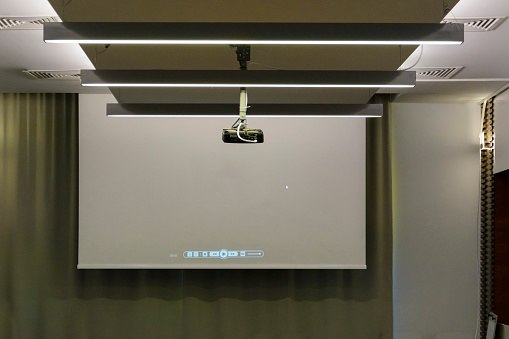In this series of posts (here is Part 1), we are looking at some steps you can take when you find that your current audiovisual system isn’t working. Even if you are not an expert on audio visual systems, there are usually steps you can take to get your presentation back up and running.
What do you do when you realize that the video that should be on screen isn’t there? Sometimes the screen is entirely black. Other times, you may see the wrong image on the screen.
The best solution is often to contact the person in charge of running and maintaining your AV equipment. However, there are times, when the presentation is about to start, you need to get things running fast.
Troubleshooting Video Display Issues
Here are a few troubleshooting steps you can take when you see no video on the screen or see the wrong video displayed.
- Check the Control Panel or Touch Pad
Many modern audio visual systems are equipped with a control panel or touch pad that controls the selection of audio and video components. If your system is equipped with a device like this, it is often the best place to start.Check to see if your device is selected on the control panel. Components are usually labeled using descriptions such as VGA, Component, or HDMI. In some cases the selections are poorly labeled or not labeled at all. You may need to experiment by choosing different components and watching to see if it resolves the issue.
- Check the Connections
A common point of failure for video signals is the cabling. Some cables may not be accessible but check the ones you can. A cable may appear to be correctly plugged in but still might not be sending a signal. Gently pull on the cable to be sure it is seated and then gently push it in to make sure it is fully engaged. Sometimes it helps to remove it entirely and gently reseat it. Be especially gentle with HDMI connections. There are internal pins that are quite fragile and can be damaged but forcing them into place. - Check the Power
It may seem obvious but check to see that the device you are using is powered on. Also look for power lights on the projector or display. If your system has a control panel or digital signal processor, check to be sure the power is on to those. - Check the Device
In some cases, you will see video on the screen, and it is coming from the correct device, but it is not the image you wish to display. This happens most often when presenting from a computer.When this occurs, check the video/screen settings on the device. PCs and Macs both allow the user to choose between mirroring the main display or extending the desktop and showing a separate image on the second display. Many times, the computer recognizes the projector or display and defaults to extended desktop.
The easiest way to check if you are in extended desktop mode is to move the mouse to the edge of the laptop/desktop screen. It should move off the edge of your display into the projected image as if it were an additional monitor.
At this point, you can either choose to change the settings on the computer or drag the content to the second display.
- Check the Projector
Check the settings on the projector itself to ensure that the correct input has been selected. This is usually done via the projectors remote control. - Try Another Device
Often the problem is not with the audio visual system itself but with the device attached to it. This is especially likely if it is a computer that is not a permanent part of the system but has been brought in for the presentation. When this is the case, it is a good idea, when possible to try another computer. If the other device works then you will know that the problem lies with the original machine.
Need Help with Your Audio Visual System?
If none of this resolves your issue, let us know. We offer troubleshooting help and can help you get components repaired or replaced. When it is time for a new system or upgrades, our knowledgeable staff has the experience and expertise to help you create and maintain the right system for your organization.
Whether you need troubleshooting help, need components repaired or replaced, or are looking for a whole new system our friendly, knowledgeable staff will take the time to make sure you get up and running again.
